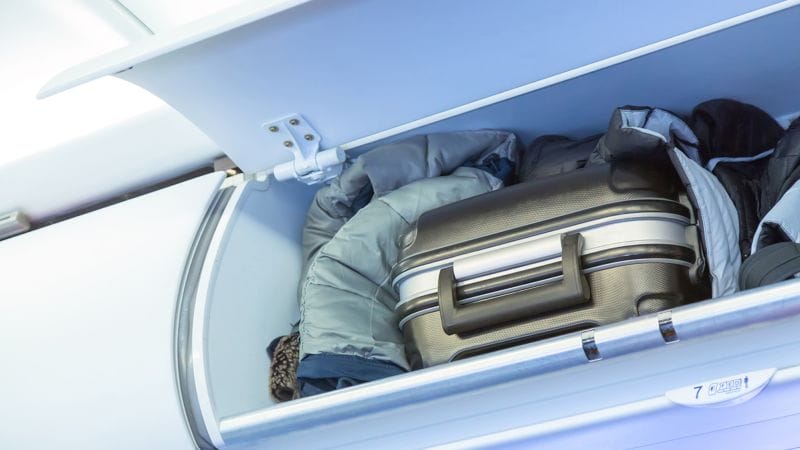Airlines refer to the maximum size for a piece of luggage in linear inches, which is calculated by adding the bag’s dimensions. This usually comprises your bag’s length, width, and height. For anyone planning a trip, whether it be a little business trip or a lengthy vacation, understanding the notion of linear inches is crucial. In particular, they should be familiar with the “45 linear inches” guideline.
It not only makes sure you pack in accordance with airline requirements, preventing any unwelcome excess luggage penalties, but it also promotes effective and careful packing. Understanding how to get around this rule will improve the ease and enjoyment of your trip. We want to help you learn the 45 linear inches rule by explaining it in this article.
Rules Regarding The 45 Linear Inches
The “45 Linear Inches Rule” is one of the most important packing guidelines that airlines all over the world follow when it comes to air travel. According to this guideline, a piece of carry-on luggage’s combined length, width, and height cannot be greater than 45 inches. The primary goal of this regulation is to guarantee that luggage fits smoothly into airplane overhead storage bins without annoying other passengers.
It’s crucial to remember that these measurements are not rigid because different airlines have varied limitations on the size of carry-on bags. While some might be a little gentler, others might be harsher. The “45 Linear Inches Rule” is a general recommendation for travelers that encourages the effective use of space, mobility, and easier boarding and releasing procedures. It encourages people to pack lightly and make sure they have what they need while avoiding excess. This regulation must be understood and followed in order to proceed with any travel plans.

How to Determine 45 Linear Inches
As many airlines have tight guidelines about luggage size, you may run across the need to calculate
45 linear inches when packing your bags for a flight. The total of a bag's length, width, and height is
its linear inches. The steps to calculate this are as follows:
Step 1: Get a Measuring Tape
You need a measuring tape that can measure in inches. These are available online or at any nearby
hardware store. For greater versatility, make sure it includes both inches and centimeters.
Step 2: Measure the Length, Width, and Height
Take measurements of the thing or luggage you are carrying with the measuring tape for its length,
width, and height. Make a note of each of these measurements. Make sure to measure edge to edge
and ignore any protruding components, such as wheels or handles.
Step 3: Calculate the Linear Inches
Once you have the dimensions, add them up to determine the linear inches. This total indicates the
linear inches. Your luggage's total linear inches would be 45 (20+15+10) if it were 20 inches long, 15
inches broad, and 10 inches high.
Step 4: Verify Your Measurements
To ensure that you have calculated the measurement correctly, it is crucial to double-check. You
may want to rethink what you're packing or look for a smaller bag if your total exceeds 45 linear
inches.
Benefits of Adhering to the 45 Linear Inches Rule
Saving money is one of the main benefits of following the 45 Linear Inches Rule. Keeping your carry-on luggage below this limit will help you avoid unwanted charges at the airport since airlines frequently charge extra fees for big carry-on bags.
Convenience is another advantage. A smaller, lighter suitcase is simpler to move around congested airports, and you won’t have to worry as much about fitting it in the overhead compartments. Following this guideline promotes effective packing. By setting a size restriction, you’re more likely to bring only the things you really need and cut down on extras and making your trip lighter. Your journey may be more enjoyable if you don’t have to carry around heavy luggage.
Tips for Packing within the 45 Linear Inches Limit
- When packing, start by deciding which items are most important to have with you. Setting your needs in order can help you avoid overpacking.
- Use packing cubes to arrange your possessions, compress clothing, and make the most of the space in your bag.
- Try rolling your clothing instead of folding them. Both space and wrinkles can be saved in this way.
- Cut back on toiletries Use just travel-sized products or think about using the ones that come with your lodging to considerable space.
- Pick items with multiple uses. A jacket that serves as both a raincoat and a pair of shorts can save a lot of room.
The Impact of Overpacking
There are a number of implications if you overpack and go over the permitted 45 linear inches for carry-on luggage. First, you may face unexpected baggage charges. Your vacation budget may be significantly increased by the additional fees most airlines charge for excessive or overweight baggage.
Second, carrying heavier bags may be difficult due to limited storage space. It can be difficult to carry heavy baggage up and down stairs, through busy trains, and through crowded airports. Additionally, it’s possible that they won’t fit in the overhead compartments on airlines, which could cause delays and trouble for both you and other passengers.

Finally, excessive packing harms the environment. A plane’s carbon emissions increase as it gains weight. You can support the global initiative to cut carbon emissions and encourage more environmentally friendly travel by packing less and following the 45 linear inches rule.
FAQs
Q: What is the linear size?
The term “linear size,” which is often referred to as “linear dimensions” or “linear measurements,” describes the total of an object’s length, width, and height. Airlines define the allowed dimensions for luggage in terms of linear size. For instance, the linear size of a suitcase is 45 inches while it is 22 inches long, 14 inches broad, and 9 inches high.
Q: Does the 45 linear inches rule apply to checked luggage?
Usually, the carry-on luggage size limit of 45 linear inches only applies to carry-on bags. Although this can vary between airlines, checked luggage often has a bigger size allowance. It’s important to review your airline’s individual luggage regulations as going overboard could result in additional fees or require you to have your suitcase sent as cargo separately.
Q: How can I ensure my bag fits within the 45 linear inches limit?
Measure your luggage’s length, breadth, and height, considering any handles or protruding wheels since these are typically taken into account by airlines when determining whether a bag fits within the 45 linear inch restriction. These measurements should be included. Your bag is within the allowed limits if the sum is 45 or less.
The Bottom Line
The ’45 linear inches rule is a fundamental concept in travel preparation, but it is more than just a packing rule. It is a reminder of how efficiency and preparation can greatly improve our trip experiences. In a world where airline regulations and baggage restrictions are always changing, it’s important to be knowledgeable and adaptable.
Successfully adhering to the weight restriction has benefits beyond only cost savings and compliance with airline regulations. These benefits include convenience. It makes it possible to move more easily through busy airports, store items more easily, and travel less anxiously.
Additionally, effective packing pushes us to think about our needs and only bring what is really necessary. Understanding the 45 linear inches rule requires us to reconsider how we travel, not just how much we can carry in our bags. It’s an effort to make traveling more thoughtful, useful, and ultimately pleasant.

After visiting more than 60 countries, I have probably been on every type of plane there is and visited countless airports. I did my very first international solo trip to South Africa at the age of only 16 and haven’t really stopped traveling since.
Despite the adventurous travel itch, I do have a nerdy side as well – which is satisfied by writing about all things aviation “too boring” for my regular travel blog.
